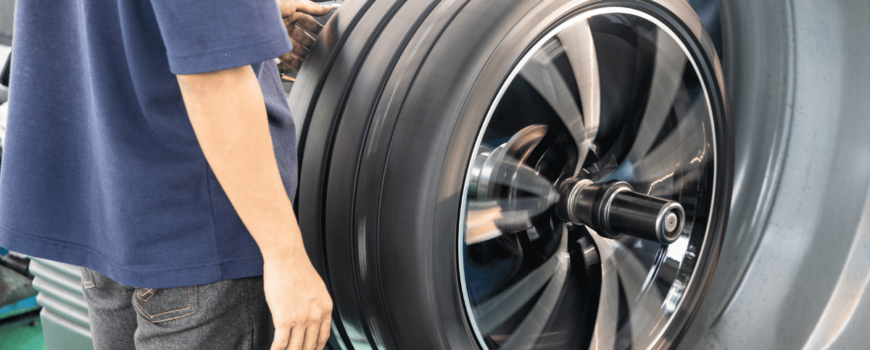Wheel balancing sometimes referred to as tyre balancing, is the act of balancing the total weight of the tyre and wheel assembly to provide a smooth, fast-spinning rotation. The wheel and tyre combination is balanced by placing it on a balancer, which spins and centres the wheel to determine where the weights should be placed.
In fact, the weight of the wheels and tyres is never precisely the same everywhere. A little amount of weight is often taken off one side of the wheel by the valve stem hole. The connecting point of the cap plies or a simple variation in the geometry of the wheel can both cause modest weight imbalances in tyres.
Buy wheel balancing machine accessories – Here
A little weight imbalance can quickly increase to a significant one at high speeds, creating a galumphing action in the wheel and tyre system. Typically, this causes the automobile to vibrate and causes the tyres to wear unevenly, which can harm them.
Traditional Spin Balancing
We put a wheel and tyre assembly on a balancing device to get it balanced. There are a few methods for manually balancing tyres, but they honestly fall short of machine balancing in terms of simplicity or accuracy. A metal cone is inserted to make sure the wheel is correctly aligned before the wheel is mounted onto the balancer’s spindle.
To identify the assembly’s heaviest location, the machine rotates the parts rapidly. The machine then instructs the operator where and how many weights should be placed on the opposing side to make up for the heavy spot.
The following are the key concepts to understand when balancing:
Balance Is Required: Every wheel/tire assembly will eventually have an unbalanced weight. Sometimes we witness an assembly come out spontaneously and properly balanced.
Balance Alterations: The balance will gradually and dynamically alter as the tyre ages. As tyres are rotated or when switching to winter/summer tyres for a second season, for instance, most reputable tyre shops will wish to rebalance them. Rebalancing the tyres at least once over their lifespan will almost probably increase their lifespan.
Only balancing restores balance: The vibrations caused by a bent wheel, an out-of-round tyre, or uneven wear cannot be eliminated by balancing. Only weight discrepancies may be addressed by balancing weights; an issue that is genuinely physical cannot be.
Road Force Balancing
The “Road Force” balancer was created because vibrations and unusual tyre wear might have other causes besides balance. In addition to doing a conventional spin balance, this kind of balancer examines the wheel and tyre to see if there are any circumstances that would be likely to generate vibration on the road.
Typically, balancers achieve this by gently spinning a huge roller across the tyre to measure radial runout and tyre pressure (i.e. deviation from perfect roundness). This can identify faults with match installation and belt separations, among other things.
Because perfection is unachievable, both wheels and tyres typically have high and low points in terms of their runout. You may visualise an egg-shaped object by dragging one point of a linked circle (such as the edge of a wheel) just a little bit outside.
This forces another point of the circle to move inward in order to preserve the connection. These are the areas where radial runout is high and low. This setup would require more weight to balance on a conventional balancer, and it would presumably still vibrate.
The answer is to measure both the wheel and the tyre, then adjust the tire’s placement on the wheel such that its high point and low point are the same. Usually, this procedure is referred to as “match mounting.” The majority of tyres now feature tiny dots on the sidewalls to show where on the tyre the valve stem should correspond for a good match mount.
Road force balancers do this task considerably more precisely by using rollers to measure the tyre and wheel and then instructing the user to indicate the places that need to match. The resultant assembly spins more straightly and needs less weight to maintain equilibrium.
Bang-On vs Adhesive Weights
Using a plastic hammer, bang-on weights, which were lead weights of various denominations with a soft lead flange, were initially applied to the edge of the wheel. While the wheels were made of steel, their weights were excellent. Nevertheless, when steel wheels were converted to alloy wheels, the weights cracked the clear coat, exposing the exposed aluminium underneath to rust.
The answer lay in Tape-A-Weights. With the use of clippers, flat adhesive-backed lead squares that weigh one and a quarter ounces apiece may be cut into strips and attached to the interior of the barrel behind the spokes. Despite the fact that the glue is fairly powerful, shrewd tyre technicians will nevertheless clean the area where the weights will be placed to remove any brake dust and grease.
By doing this, the weights won’t drop. A piece of duct tape covering the weights will hold through almost anything if there is any doubt about the adhesive holding. When it’s too hot for the weights’ glue to hold, racing mechanics employ duct tape to keep them on the wheels.
So that’s why it’s a heinous sin to use bang-on weights on the face of an aluminium alloy wheel. While having your alloy wheels balanced, always request adhesive weights. Any tyre shop that does not employ adhesive weights should be avoided. Several locations will employ adhesive weights on the outboard side and bang-on weights on the inside flange of the wheel. (Bang-on weights often cost less.) Unless you have chrome wheels, this is typically totally okay. Any crack in the chrome can start the flaking process, which can eventually be fatal.

